Pavona Coral - Cactus coral
Albert J. Thiel 2013
Of all of the SPS type corals available in the bobby for Reefs and Nano-Reefs, this is probably one of the easiest ones to keep and, not being too demanding on water quality, on light and on flow, Pavona is an excellent coral for the beginner and for any other Hobbyist for that matter. It truly is an easy coral to keep, grow, frag and to keep in great shape.
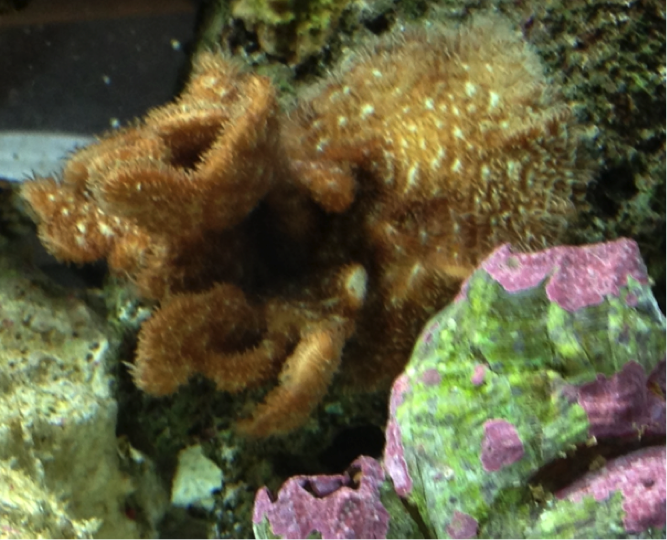
Large Pavona growing outward and upward © A. Thiel – In Author’s Nano-Reef
The Pavona spp. shown above is growing outward on the large rock it is on, and in a really flat form, meaning a thin layer that expands upwards on the rock, and then to the left of it you can see the branching and curling pieces of it that are growing upwards. Note that since this picture was taken the rock has been moved and the coral is now positioned the other way around with the flat growth on the other side of the curly growths.
If you look closely at the image above and the one below, you can see the short tentacles that the Pavona coral extends to capture food particles. The small flat patch to the right extends about 1.5 inches from the main colony, and the white spot you see in the image above is now no longer present in the one below, as the Pavona has grown some more since that picture was taken. Note that the pictures were taken about 2 weeks apart, so the growth occurred fairly quickly, typical of this type of coral.
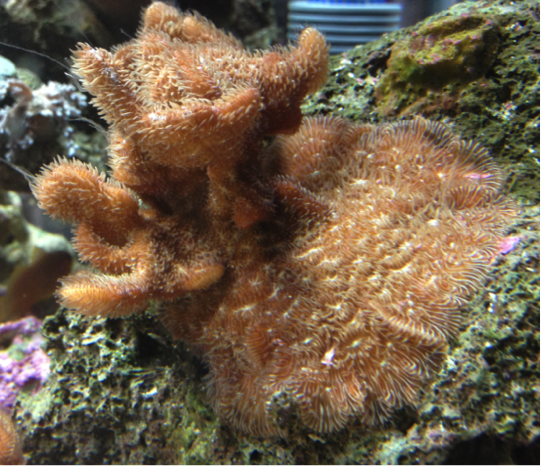
The same Pavona growth but as you can see the white spot is no longer present
The reason there was a white spot to begin with, is that I fragged a piece off the main growth and glued it to a piece of rock, and placed it nearby the other frags of Pavona I already have in my Nano-Reef. You can see how that piece is doing after about 3 days of having been broken off that main part in the image below. It is the one in the middle towards the front.
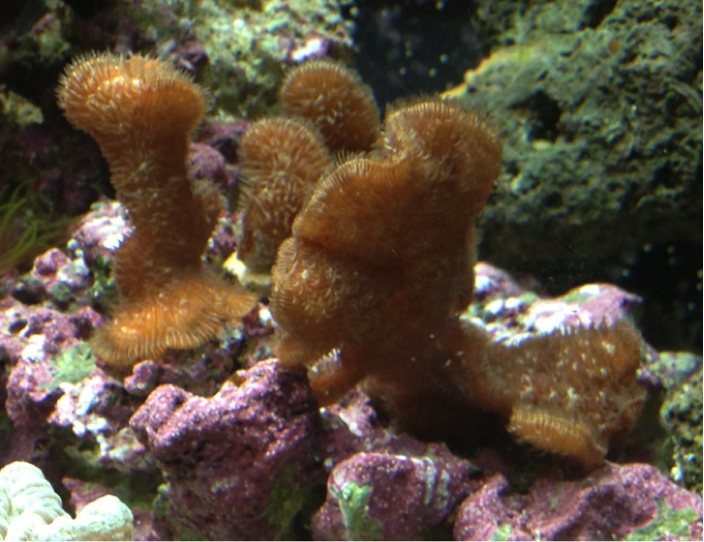
A view of all the Pavona frags I have including the one referred to above
Pavona corals are much hardier than most other SPS corals. They are tolerant of most Aquarium Nano-reef type set-ups, doing well under less intense light and are in addition quite disease resistant. They also appear to be very adaptable to not so ideal water quality. However there are obviously limitations to how far the water quality can drop. It should still remain close to what generally acceptable reef aquarium conditions should be.
There are some unique characteristics in the Pavona genus. One is that the genus contains some of the most “autotrophic” species known. Autotrophic is the ability to take simple inorganic substances, such as carbon dioxide, and turn them into organic substances that they can then use for food. Pavona corals make up for less light by absorbing more nutrients in that manner and, therefore, do not require high end LED or even sophisticated types of lighting as is usually needed for other SPS type corals.
In essence if they do not get enough nutrients or “food” from photosynthesis they switch to the autotrophic mode, and obtain some of their nutrition from their symbiotic algae, and some from uptaking dissolved organics from the water and even, as mentioned, using carbon dioxide to turn it in organic carbon sources they can feed on.
Under bright light they do very well without extra feeding, however providing extra food is certainly not going to harm them, and may, therefore, as well be done to promote even better growth.
Another characteristic pointed out by several authors, including Moosleitner, Erhardt and Borneman, is that they can form uncalcified tissue buds on their surface that look like prickly little balloons. Though these growths are decorative, their purpose is unknown. It is known that these buds are not a form of asexual reproduction.
I have also seen little upright growths of what appears to be calcified material, growths that are dark in color when they first start off, but that in a relatively short period of time start to show polyp growth that rises from the base of that growth, upwards, until the little “pillar” is covered in short tentacles like the rest of the Pavona coral. You can actually see such a dark growth in the pictures below. That one has not started to show any polyp growth.
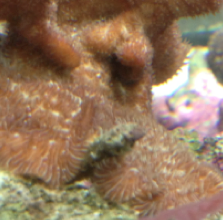
Dark growth not covered with Polyps yet
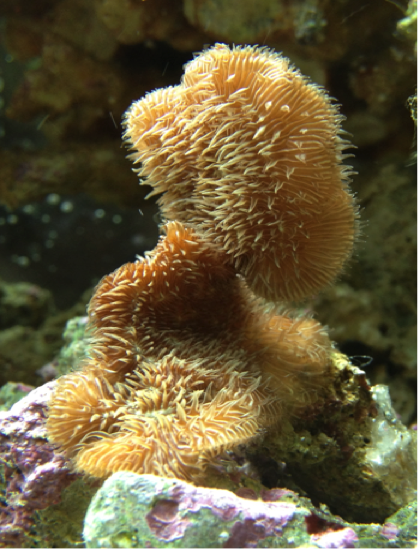
Another Frag broken off the main Growth after 4 days in the Author’s Nano-Reef
Well over 50 species of Pavona are known but only few are offered for sale in the trade: P. cactus, P. decussata and P. maldivensis are the ones most frequently encountered. The latter however is not as easily found and grows a little differently, not as leafy looking as most of the others, but more stubby in its individual growths. The most frequently encountered one is P. cactus, which is probably the reason that the coral is generally referred to by the common name of Cactus coral.
As indicated lighting needs to be bright but not extremely sophisticated, in fact I keep mine under 2 CFT (Compact Fluorescent Tubes) that are rated at 100 Watt equivalent and have a 6500 Kelvin degree rating. Water flow needs to be moderate to stronger and the coral easily adapt to a number of different current flows, as long as the flow is not laminar but somewhat varying in the direction it is coming from. Aiming the output of a power head pump directly at it, even from a distance, is not recommended.
Besides the lighting suggested and water flow already mentioned, keep your calcium levels up at 420-450-ppm and the temperature around 78-80 F, pH 8.0-8.2, dKH 8-12.
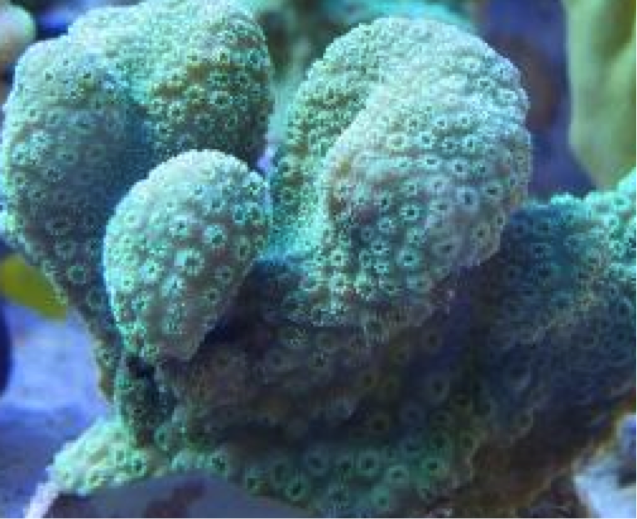
Pavona maldivensis © sealife
Besides the parameters listed above, make sure your magnesium ones are at the right level as well (1250 to 1350-ppm) as if they are too low, your calcium will be as well, or will be difficult to maintain at the desired level, and by adjusting the magnesium one your calcium levels will be far easier to maintain in the right range of 420 to 450-ppm, or somewhat higher if needed for other corals (up to 480-ppm).
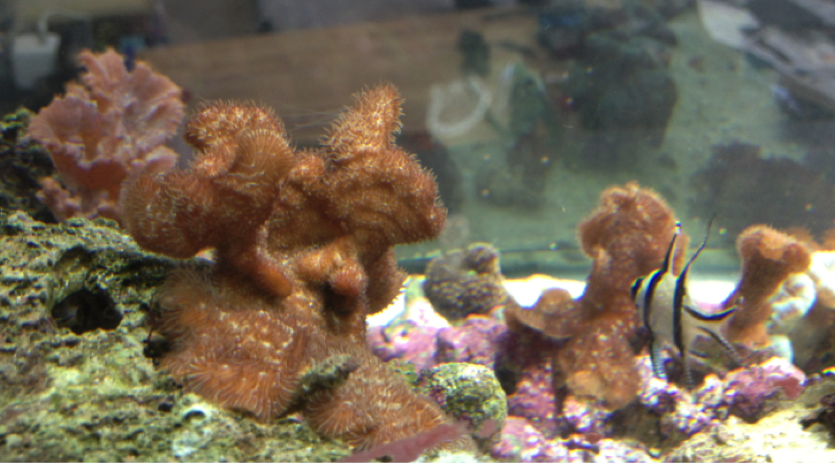
Another view of the large cluster with the image taken from the back of the tank
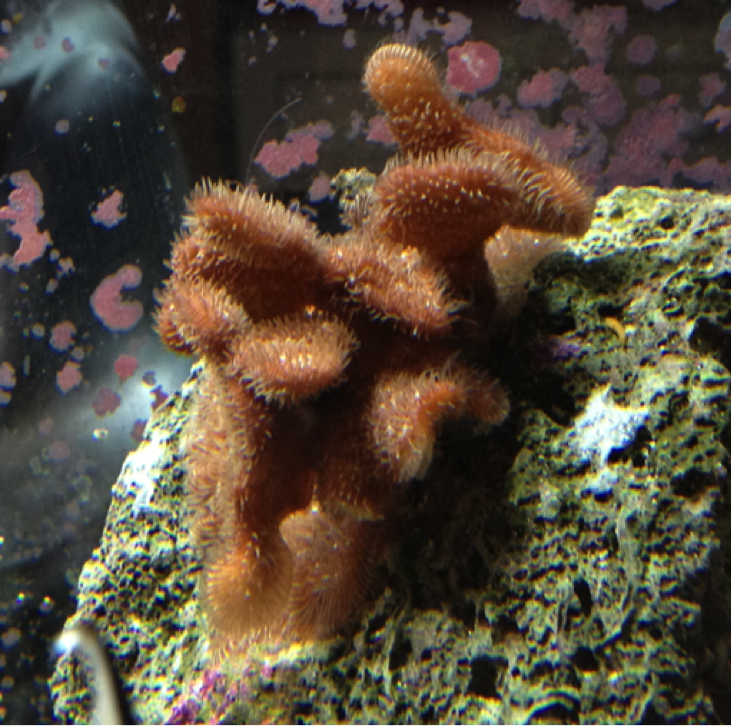
Close-up of the Large Cluster in the Author’s Nano-Reef
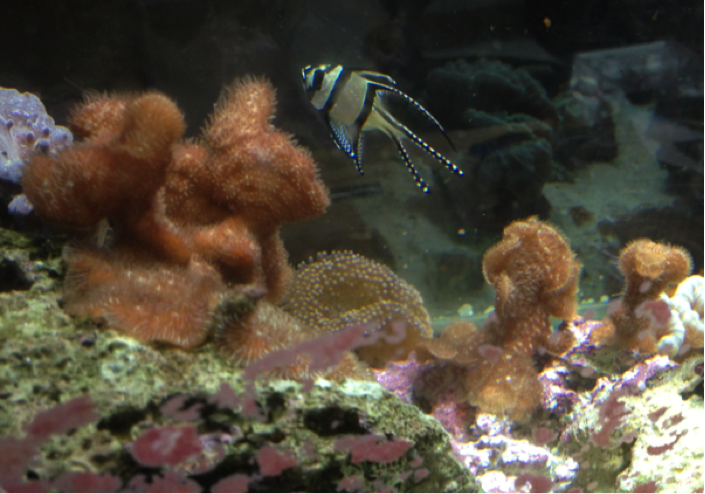
Another view from the back of the tank, you can see coralline algae growth on the glass and my Banggai Cardinal
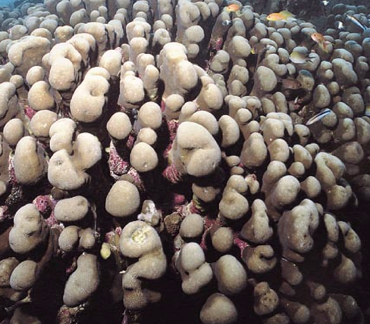
Pavona clavus © fobweb
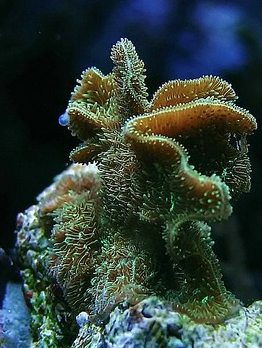
Pavona decussata © meerwasserwiki
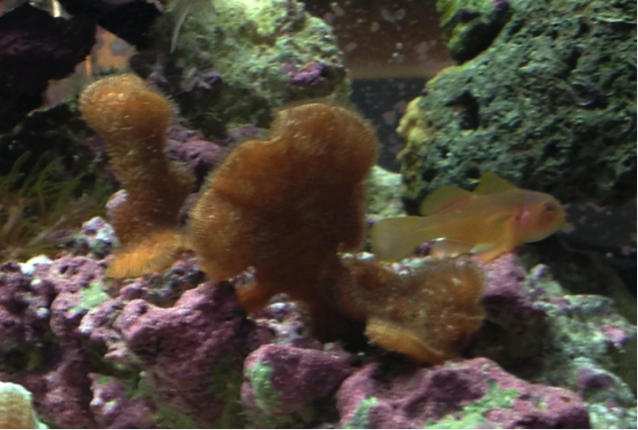
Two frags that were in the Nano-Reef before additional ones were added, and my Citron Goby (Gobiodon citrinus)
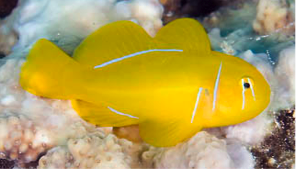
Citron Goby
Albert J. Thiel 2013
Of all of the SPS type corals available in the bobby for Reefs and Nano-Reefs, this is probably one of the easiest ones to keep and, not being too demanding on water quality, on light and on flow, Pavona is an excellent coral for the beginner and for any other Hobbyist for that matter. It truly is an easy coral to keep, grow, frag and to keep in great shape.

Large Pavona growing outward and upward © A. Thiel – In Author’s Nano-Reef
The Pavona spp. shown above is growing outward on the large rock it is on, and in a really flat form, meaning a thin layer that expands upwards on the rock, and then to the left of it you can see the branching and curling pieces of it that are growing upwards. Note that since this picture was taken the rock has been moved and the coral is now positioned the other way around with the flat growth on the other side of the curly growths.
If you look closely at the image above and the one below, you can see the short tentacles that the Pavona coral extends to capture food particles. The small flat patch to the right extends about 1.5 inches from the main colony, and the white spot you see in the image above is now no longer present in the one below, as the Pavona has grown some more since that picture was taken. Note that the pictures were taken about 2 weeks apart, so the growth occurred fairly quickly, typical of this type of coral.

The same Pavona growth but as you can see the white spot is no longer present
The reason there was a white spot to begin with, is that I fragged a piece off the main growth and glued it to a piece of rock, and placed it nearby the other frags of Pavona I already have in my Nano-Reef. You can see how that piece is doing after about 3 days of having been broken off that main part in the image below. It is the one in the middle towards the front.

A view of all the Pavona frags I have including the one referred to above
Pavona corals are much hardier than most other SPS corals. They are tolerant of most Aquarium Nano-reef type set-ups, doing well under less intense light and are in addition quite disease resistant. They also appear to be very adaptable to not so ideal water quality. However there are obviously limitations to how far the water quality can drop. It should still remain close to what generally acceptable reef aquarium conditions should be.
There are some unique characteristics in the Pavona genus. One is that the genus contains some of the most “autotrophic” species known. Autotrophic is the ability to take simple inorganic substances, such as carbon dioxide, and turn them into organic substances that they can then use for food. Pavona corals make up for less light by absorbing more nutrients in that manner and, therefore, do not require high end LED or even sophisticated types of lighting as is usually needed for other SPS type corals.
In essence if they do not get enough nutrients or “food” from photosynthesis they switch to the autotrophic mode, and obtain some of their nutrition from their symbiotic algae, and some from uptaking dissolved organics from the water and even, as mentioned, using carbon dioxide to turn it in organic carbon sources they can feed on.
Under bright light they do very well without extra feeding, however providing extra food is certainly not going to harm them, and may, therefore, as well be done to promote even better growth.
Another characteristic pointed out by several authors, including Moosleitner, Erhardt and Borneman, is that they can form uncalcified tissue buds on their surface that look like prickly little balloons. Though these growths are decorative, their purpose is unknown. It is known that these buds are not a form of asexual reproduction.
I have also seen little upright growths of what appears to be calcified material, growths that are dark in color when they first start off, but that in a relatively short period of time start to show polyp growth that rises from the base of that growth, upwards, until the little “pillar” is covered in short tentacles like the rest of the Pavona coral. You can actually see such a dark growth in the pictures below. That one has not started to show any polyp growth.

Dark growth not covered with Polyps yet

Another Frag broken off the main Growth after 4 days in the Author’s Nano-Reef
Well over 50 species of Pavona are known but only few are offered for sale in the trade: P. cactus, P. decussata and P. maldivensis are the ones most frequently encountered. The latter however is not as easily found and grows a little differently, not as leafy looking as most of the others, but more stubby in its individual growths. The most frequently encountered one is P. cactus, which is probably the reason that the coral is generally referred to by the common name of Cactus coral.
As indicated lighting needs to be bright but not extremely sophisticated, in fact I keep mine under 2 CFT (Compact Fluorescent Tubes) that are rated at 100 Watt equivalent and have a 6500 Kelvin degree rating. Water flow needs to be moderate to stronger and the coral easily adapt to a number of different current flows, as long as the flow is not laminar but somewhat varying in the direction it is coming from. Aiming the output of a power head pump directly at it, even from a distance, is not recommended.
Besides the lighting suggested and water flow already mentioned, keep your calcium levels up at 420-450-ppm and the temperature around 78-80 F, pH 8.0-8.2, dKH 8-12.

Pavona maldivensis © sealife
Besides the parameters listed above, make sure your magnesium ones are at the right level as well (1250 to 1350-ppm) as if they are too low, your calcium will be as well, or will be difficult to maintain at the desired level, and by adjusting the magnesium one your calcium levels will be far easier to maintain in the right range of 420 to 450-ppm, or somewhat higher if needed for other corals (up to 480-ppm).

Another view of the large cluster with the image taken from the back of the tank

Close-up of the Large Cluster in the Author’s Nano-Reef

Another view from the back of the tank, you can see coralline algae growth on the glass and my Banggai Cardinal

Pavona clavus © fobweb

Pavona decussata © meerwasserwiki

Two frags that were in the Nano-Reef before additional ones were added, and my Citron Goby (Gobiodon citrinus)

Citron Goby
© Albert J. Thiel 2013
Last edited:





















